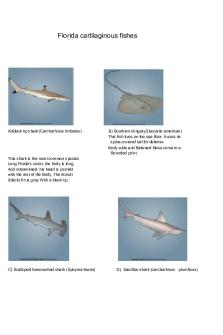IDGQuiz-Tetrapods - Bio assignment PDF

| Title | IDGQuiz-Tetrapods - Bio assignment |
|---|---|
| Author | Anonymous User |
| Course | Biochemistry I |
| Institution | Colorado College |
| Pages | 4 |
| File Size | 291.7 KB |
| File Type | |
| Total Downloads | 10 |
| Total Views | 168 |
Summary
Bio assignment...
Description
Short Film Great Transitions: The Origins of Tetrapods
Student Quiz
3/15/2021
Cameron Follett _________________________________!
_____________________!
NAME%
DATE%
1. When%Charles%Darwin%considered%some%of%the%unique%structures%found%in%modern%animals,%like%the%feathered wings%of%birds,%he%famously%proposed%that%modern%animals%must%have%evolved%from%earlier%forms%that%lacked those%structures.%He%also%predicted%________________.%(Fill%in%the%blank%with%one%of%the%statements%below.) a. that%it%would%be%impossible%to%find%fossil%evidence%for%this%idea%because%the%fossil%record%is%so incomplete. b. that%genetic%evidence%would%show%that%all%organisms%share%a%common%ancestor. c. that%fossils%would%be%found%with%structures%that%are%intermediate%between%early%and%modern%forms. d. that%fossil%evidence%would%instead%show%that%all%modern%animals%have%always%existed%in%their%present%form. 2. Which%of%the%following%features%describe%Tiktaalik? i.
Neck
ii. Lungs iii. Round%head iv. Fins a. ii%and%iv%only b. i,%ii,%and%iv c. i,%iii,%and%iv d. i,%ii,%iii,%and%iv% 3. Examine%the%table%below%and%select%the%row%that%best%describes%the%setting,%resources,%and%scientific processes%used%during%the%Tiktaalik%expeditions.
a.% b.% c.% d.%
Location! Canadian%Arctic% Iceland% Alaska% Arctic%Circle%
www.BioInteractive.org!
Maps/Photos! Geological%maps% Road%maps% Aerial%photos% Animal%track%maps%
Scientific!Process! Hypotheses%testing% Predicting% Questioning% Developing%explanations%
Published!November!2014! Revised!March!2017! Page!1!of!4!
Short Film Great Transitions: The Origins of Tetrapods!
Student Quiz
4.% Which%statement%below%is%evidence%that%all%tetrapods%shared%a%single%common%ancestor?%% a.% All%tetrapods%live%partly%in%water%and%partly%on%land.% b.% All%tetrapods%are%warm-blooded.% c.% All%tetrapod%limbs%consist%of%rearranged%fish%fin%rays.%% d.% All%tetrapod%limbs%have%a%common%pattern%of%one%bone,%two%bones,%many%bones,%then%digits.% % 5.% The%transition%from%fish%to%tetrapods%is%best%described%as:% a. Like%most%of%the%great%transitions%in%evolutionary%history,%it%happened%in%very%few%big%steps%so%that% there%are%very%few%intermediate%forms.% % b. Like%most%of%the%great%transitions%in%evolutionary%history,%it%happened%in%many%small%steps%leading%to% many%intermediate%forms.% c. Like%no%other%transition%in%evolutionary%history,%it%happened%in%many%steps,%so%there%are%many% intermediate%forms.% d. Like%most%of%the%great%transitions%in%evolutionary%history,%it%happened%in%a%single%step%with%no% intermediate%forms.%% %
6.% Which%evidence%supports%the%fact%that%tetrapods%and%fish%are%closely%related?% i.% The%embryos%of%modern%fish%and%tetrapod%look%similar.% ii.% Both%modern%fish%and%tetrapods%can%swim.% iii.% Both%modern%fish%and%tetrapods%are%vertebrates.% iv.% The%DNA%of%modern%fish%and%tetrapods%suggests%that%they%have%a%common%ancestor.% v.% Modern%fish%have%limb%bones%that%support%their%bodies.% a. i,%ii,%and%v%only% b. i,%iii,%and%iv%only% c. iii%and%v%only% d. i%to%v%are%all%supporting%evidence% % 7.% True%or%False.%“Transitional%organisms%are%not%actual%species.”%Justify%your%answer%in%one%or%two%sentences.%
False, because transitional forms are species in their own way. They are called transitional forms because they have traits like fins, that are found in earlier animals.
! www.BioInteractive.org! !
Published!November!2014! Revised!March!2017! Page!2!of!4!
Short Film Great Transitions: The Origins of Tetrapods!
Student Quiz
8.% Study%the%graphic%below%of%rock%layers%with%fossils%in%them.%Explain%how%Neil%Shubin%and%his%team%predicted% that%they%would%find%a%fossil%animal%like%Tiktaalik%in%rocks%around%375%million%years%old.% % % % % % % % % % % %
! ! ! ! ! ! !
Shubin knew that before 385 the fossil record does not contain tetrapods.
9.% The%diagrams%below%illustrate%the%bones%in%the%forelimbs%of%four%different%organisms.%Although%these%limbs% all%look%different,%they%share%some%common%patterns.%These%common%patterns%suggest%that%% % % % % % % % % % % a. These%organisms%are%members%of%the%same%species.% b. The%organisms%existed%at%about%the%same%point%in%time.% c. These%organisms%share%a%common%ancestor.% d. These%organisms%have%exactly%the%same%genes.%% ! www.BioInteractive.org! !
Published!November!2014! Revised!March!2017! Page!3!of!4!
Short Film Great Transitions: The Origins of Tetrapods!
Student Quiz
10.% Explain%why%Neil%Shubin%and%his%colleagues%had%to%travel%to%an%area%above%the%Arctic%Circle%to%find%the%fossil% of%an%animal%that%once%lived%in%a%warm%swamplike%habitat.% % %
When Tiktaalik lived and became fossilized, the continent it was on was closer to Earth’s equator where warm, freshwater areas were not scarce.
% % % % 11.% In%the%film,%Neil%Shubin%is%shown%hiking%up%a%rocky%hillside%while%recalling%for%us%one%of%the%exciting%moments% during%the%hunt%for%a%Tiktaalik-like%fossil%animal.%Neil%says,%“Beneath%our%feet%were%fossil%fish%bones,% fragments%of%fossil%fish%bones,%many%thousands%of%pieces.%It%wasn’t%just%one%fish;%it%was%a%whole%aquarium,%it% was%different%species.”%What%did%this%discovery%mean%for%the%fossil-hunting%team?% %
% %
The fossilized fish bones were evidence that the team had discovered a layer of rock that had formed in the kind of habitat where an animal like Tiktaalik could also have lived.
% % % % % % % % %
! www.BioInteractive.org! !
Published!November!2014! Revised!March!2017! Page!4!of!4!...
Similar Free PDFs

Bio Assignment 5
- 4 Pages

Bio Assignment 2A
- 3 Pages

BIO 101 - Homeostasis Assignment
- 2 Pages

Bio evolution assignment
- 2 Pages

BIO 203 Recitation Assignment 2
- 3 Pages

BIO 1121 Unit 2 Assignment
- 6 Pages

Bio of cancer assignment 3
- 3 Pages

BIO 220 Topic 4 Assignment
- 5 Pages

BIO 220 Topic 3 Assignment
- 3 Pages

Bio of cancer assignment 4
- 3 Pages
Popular Institutions
- Tinajero National High School - Annex
- Politeknik Caltex Riau
- Yokohama City University
- SGT University
- University of Al-Qadisiyah
- Divine Word College of Vigan
- Techniek College Rotterdam
- Universidade de Santiago
- Universiti Teknologi MARA Cawangan Johor Kampus Pasir Gudang
- Poltekkes Kemenkes Yogyakarta
- Baguio City National High School
- Colegio san marcos
- preparatoria uno
- Centro de Bachillerato Tecnológico Industrial y de Servicios No. 107
- Dalian Maritime University
- Quang Trung Secondary School
- Colegio Tecnológico en Informática
- Corporación Regional de Educación Superior
- Grupo CEDVA
- Dar Al Uloom University
- Centro de Estudios Preuniversitarios de la Universidad Nacional de Ingeniería
- 上智大学
- Aakash International School, Nuna Majara
- San Felipe Neri Catholic School
- Kang Chiao International School - New Taipei City
- Misamis Occidental National High School
- Institución Educativa Escuela Normal Juan Ladrilleros
- Kolehiyo ng Pantukan
- Batanes State College
- Instituto Continental
- Sekolah Menengah Kejuruan Kesehatan Kaltara (Tarakan)
- Colegio de La Inmaculada Concepcion - Cebu





